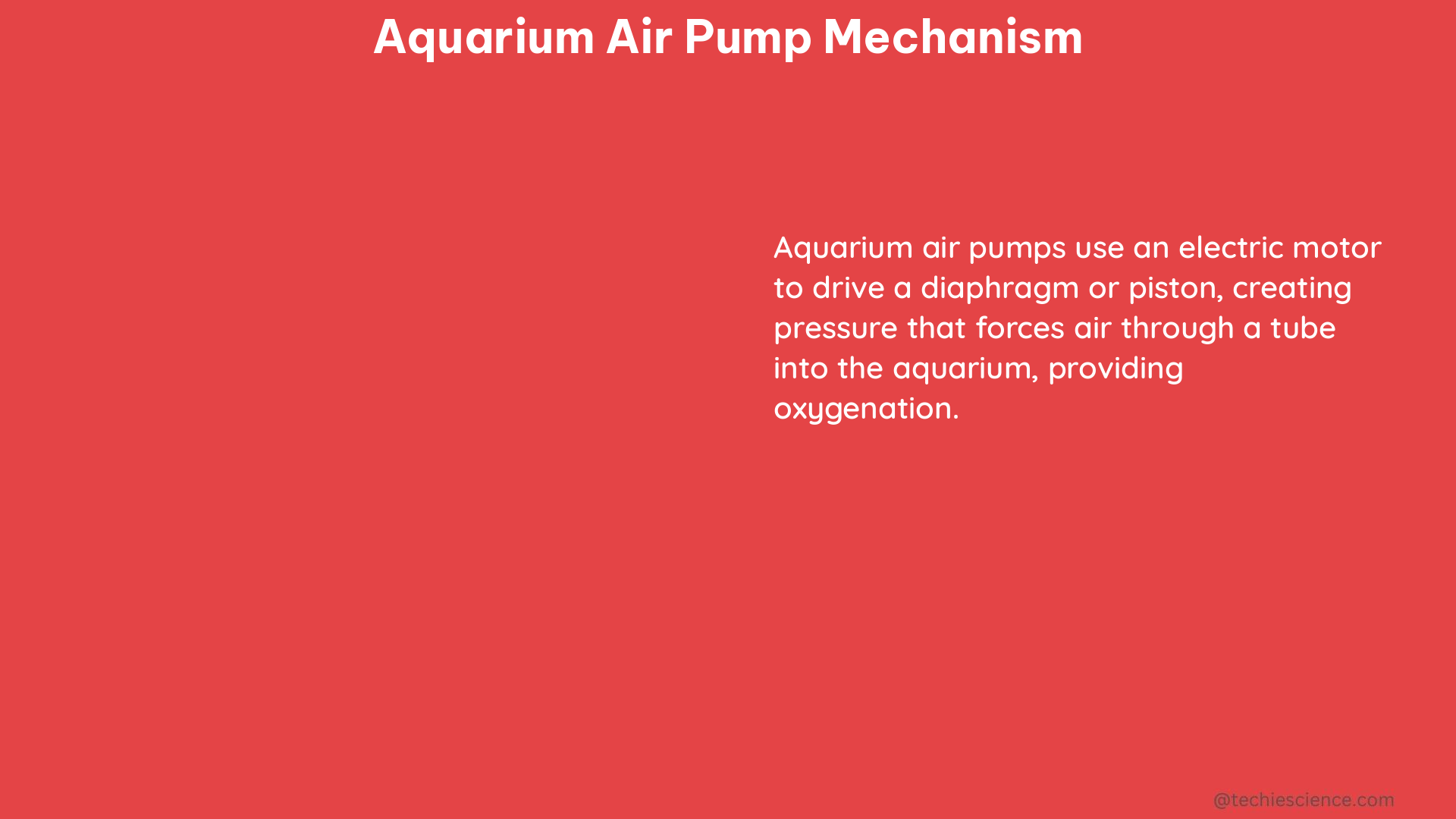The aquarium air pump mechanism is a crucial component in maintaining a healthy and thriving aquatic ecosystem. By converting electrical energy into mechanical energy, these pumps displace water with air bubbles, increasing the agitation and oxygenation of the water. This process ensures that fish and other aquatic life have sufficient oxygen to breathe, regardless of the tank’s size or water conditions.
Understanding the Fundamentals of Aquarium Air Pumps
Aquarium air pumps work by using an electric motor to drive a diaphragm or piston, which in turn creates a pressure differential that draws air into the pump and forces it out through the air tubing and into the aquarium. The output of an air pump is typically measured in gallons per hour (GPH), with a general rule of thumb being that the pump should have an output of at least 1 GPH for every gallon of water in the tank.
Key Components of an Aquarium Air Pump
- Electric Motor: The heart of the air pump, the electric motor converts electrical energy into mechanical energy to power the diaphragm or piston.
- Diaphragm or Piston: This component is responsible for creating the pressure differential that draws in and expels air.
- Air Intake: The air intake allows atmospheric air to be drawn into the pump.
- Air Outlet: The air outlet connects the pump to the air tubing, which carries the air bubbles into the aquarium.
- One-Way Valve: This valve ensures that air only flows in one direction, preventing backflow and maintaining the desired air pressure.
- Casing: The casing protects the internal components and can be made of various materials, such as plastic or aluminum, depending on the pump’s design and intended use.
Factors Affecting Air Pump Performance
- Tank Size: The size of the aquarium directly impacts the required air pump output. As a general rule, the air pump should have a GPH rating that is at least equal to the tank volume in gallons.
- Water Depth: Deeper tanks require more air pressure to overcome the increased water pressure, so a more powerful air pump may be necessary.
- Water Conditions: Factors like temperature, pH, and dissolved solids can affect the air pump’s efficiency and the amount of oxygen the water can hold.
- Air Tubing and Accessories: The length and diameter of the air tubing, as well as the number and type of accessories (e.g., air stones, check valves) connected to the pump, can impact the overall air flow and pressure.
Comparing High-Quality Aquarium Air Pumps

Two popular and high-quality aquarium air pumps are the EcoPlus Commercial Air 1 and the EcoPlus Commercial Air 3.
EcoPlus Commercial Air 1
- Maximum Output: 793 GPH
- Designed for: Aquariums, fish farms, and hydroponic systems
- Features:
- Quiet operation
- 6-port chrome air manifold
- Durable plastic casing
EcoPlus Commercial Air 3
- Maximum Output: 1030 GPH
- Designed for: Larger aquariums, fish farms, and hydroponic systems
- Features:
- Upgraded version of the Commercial Air 1
- Aluminum casing for increased durability
- Suitable for larger tanks and systems
Monitoring and Maintaining Aquarium Air Pumps
Proper monitoring and maintenance of aquarium air pumps are crucial to ensure the health and well-being of the aquatic ecosystem. There are two primary methods for monitoring air pump performance:
Analogical Monitoring
This method involves using a tee connector to divert a small fraction of the air flow through a flow control clamp and into a jar filled with water. By squeezing the clamp on the secondary tube, the air bubbles in the monitoring jar can be observed. If the one-way valve becomes stuck, the increased bubbling in the jar will indicate a problem.
Digital Monitoring using Arduino
This approach utilizes digital barometric 40KPa pressure sensor modules to monitor the pressure between the air pump outlet and the one-way stop valve. By setting thresholds for pressure drops or rises, the system can send notifications when issues arise, allowing for proactive maintenance and preventing potential failures.
DIY Aquarium Air Pump Mechanisms
While commercial air pumps offer reliable and efficient performance, some aquarium enthusiasts may explore DIY options. A research paper from Mindanao State University – General Santos examined the effectiveness of a homemade air pump as a quality assessment source of oxygen for fish tanks. The study compared the performance of the homemade air pump with conventional commercial alternatives, providing insights into its effectiveness, cost savings, and potential ecological benefits.
Conclusion
The aquarium air pump mechanism is a crucial component in maintaining a healthy and thriving aquatic ecosystem. By understanding the fundamental principles, key components, and factors affecting air pump performance, aquarium enthusiasts can make informed decisions when selecting and maintaining their air pumps. The comparison of high-quality commercial options, as well as the exploration of DIY alternatives, offers a comprehensive understanding of the aquarium air pump mechanism and its role in supporting the well-being of aquatic life.
References
- Reddit Discussion on Aquarium Air Pump Monitoring
- What is an Aquarium Air Pump and Is It Necessary?
- Aquarium Air Pump Monitoring System using Arduino
- Cliffs Notes on Aquarium Air Pump Mechanism
- DIY Aquarium Air Pump Mechanism Video
- Research Paper on Homemade Air Pump for Fish Tanks
